Punching Shear Capacity of Recycled Aggregate Concrete Slabs
Abstract
1. Introduction
2. Experimental Investigation
2.1. Material Properties
2.2. Concrete Mix Proportions
2.3. Details of Slab Specimens
2.4. Test Setup and Testing Procedure
3. Results and Discussion
3.1. Observed Damage
3.2. Load-Deflection Response
3.3. Punching Shear Failure Loads and Comparison with ACI 318-19 and Eurocode 2
3.4. Prediction of Shear Strength Ratios using Extended Dataset
3.5. Yield-Line Analysis
4. Conclusions
- The normalized punching shear strength of 100% RAC slabs was lower than those of the NAC counterparts by 6.5% and 9% for flexural reinforcement ratios of ρ = 1.5% and 0.8%, respectively.
- Doubling the flexural reinforcement ratio increased the punching shear strength of RAC slabs by 45%.
- Based on the punching shear strength database, Eurocode 2 proved to give a more conservative prediction of punching shear strength with a mean shear strength ratio of 1.34, against a ratio of 1.39 given by ACI 318.
- Based on the database of punching shear strength, the ACI 318-19 can predict unconservative punching shear strengths for slabs with high concrete compressive strength but low flexural reinforcement ratios (ρ = 0.56%). The lowest shear strength ratio was 0.87, indicating a lower punching shear prediction (by 13%) compared to the test result.
- Except for slabs with a low reinforcement ratio below 0.6%, ACI 318-19 generally gives a conservative prediction for punching shear strength of RAC slabs at all levels of RCA contents.
- Based on the experimental evidence to date, both ACI 318-19 and Eurocode 2 can be used conservatively to predict the punching shear capacity of RAC slabs with reinforcement ratios greater than 0.6%.
- The yield-line analysis shows that RAC slabs failed by a punching shear mode, which is consistent with the test results.
5. Design Recommendation and Future Work
Author Contributions
Funding
Institutional Review Board Statement
Informed Consent Statement
Data Availability Statement
Acknowledgments
Conflicts of Interest
Appendix A

References
- Wang, B.; Yan, L.; Fu, Q.; Kasal, B. A comprehensive review on recycled aggregate and recycled aggregate concrete. Resour. Conserv. Recycl. 2021, 171, 105565. [Google Scholar] [CrossRef]
- Liew, K.M.; Sojobi, A.O.; Zhang, L.W. Green concrete: Prospects and challenges. Constr. Build. Mater. 2017, 156, 1063–1095. [Google Scholar] [CrossRef]
- Khatib, J.; Jahami, A.; Elkordi, A.; Baalbaki, O. Structural performance of reinforced concrete beams containing plastic waste caps. Mag. Civ. Eng. 2019, 7, 73–79. [Google Scholar]
- Mohammed, A.A. Flexural behavior and analysis of reinforced concrete beams made of recycled PET waste concrete. Constr. Build. Mater. 2017, 155, 593–604. [Google Scholar] [CrossRef]
- Tam, V.W.Y.; Soomro, M.; Evangelista, A.C.J. A review of recycled aggregate in concrete applications (2000–2017). Constr. Build. Mater. 2018, 172, 272–292. [Google Scholar] [CrossRef]
- Makul, N.; Fediuk, R.; Mugahed Amran, H.; Zeyad, A.M.; de Azevedo, A.R.G.; Klyuev, S.; Vatin, N.; Karelina, M. Capacity to Develop Recycled Aggregate Concrete in South East Asia. Buildings 2021, 11, 234. [Google Scholar] [CrossRef]
- Kisku, N.; Joshi, H.; Ansari, M.; Panda, S.; Nayak, S.; Dutta, S.C. A critical review and assessment for usage of recycled aggregate as sustainable construction material. Constr. Build. Mater. 2017, 131, 721–740. [Google Scholar] [CrossRef]
- Sunayana, S.; Barai, S.V. Flexural performance and tension-stiffening evaluation of reinforced concrete beam incorporating recycled aggregate and fly ash. Constr. Build. Mater. 2018, 174, 210–223. [Google Scholar] [CrossRef]
- Seara-Paz, S.; González-Fonteboa, B.; Martínez-Abella, F.; Eiras-López, J. Flexural performance of reinforced concrete beams made with recycled concrete coarse aggregate. Eng. Struct. 2018, 156, 32–45. [Google Scholar] [CrossRef]
- Arezoumandi, M.; Smith, A.; Volz, J.S.; Khayat, K.H. An experimental study on flexural strength of reinforced concrete beams with 100% recycled concrete aggregate. Eng. Struct. 2015, 88, 154–162. [Google Scholar] [CrossRef]
- Ignjatović, I.S.; Marinković, S.B.; Mišković, Z.M.; Savić, A.R. Flexural behavior of reinforced recycled aggregate concrete beams under short-term loading. Mater. Struct. 2013, 46, 1045–1059. [Google Scholar] [CrossRef]
- Choi, W.-C.; Yun, H.-D. Long-term deflection and flexural behavior of reinforced concrete beams with recycled aggregate. Mater. Des. 2013, 51, 742–750. [Google Scholar] [CrossRef]
- Song, S.-H.; Choi, K.-S.; You, Y.-C.; Kim, K.-H.; Yun, H.-D. Flexural behavior of reinforced recycled aggregate concrete beams. J. Korea Concr. Inst. 2009, 21, 431–439. [Google Scholar] [CrossRef]
- Ajdukiewicz, A.B.; Kliszczewicz, A.T. Comparative tests of beams and columns made of recycled aggregate concrete and natural aggregate concrete. J. Adv. Concr. Technol. 2007, 5, 259–273. [Google Scholar] [CrossRef]
- Yu, F.; Wang, M.; Yao, D.; Yang, W. Study on Flexural Behavior of Self-Compacting Concrete Beams with Recycled Aggregates. Buildings 2022, 12, 881. [Google Scholar] [CrossRef]
- Setkit, M.; Leelatanon, S.; Imjai, T.; Garcia, R.; Limkatanyu, S. Prediction of Shear Strength of Reinforced Recycled Aggregate Concrete Beams without Stirrups. Buildings 2021, 11, 402. [Google Scholar] [CrossRef]
- Wardeh, G.; Ghorbel, E. Shear strength of reinforced concrete beams with recycled aggregates. Adv. Struct. Eng. 2019, 21, 1369433219829815. [Google Scholar] [CrossRef]
- Rahal, K.N.; Alrefaei, Y.T. Shear strength of recycled aggregate concrete beams containing stirrups. Constr. Build. Mater. 2018, 191, 866–876. [Google Scholar] [CrossRef]
- Pradhan, S.; Kumar, S.; Barai, S.V. Shear performance of recycled aggregate concrete beams: An insight for design aspects. Constr. Build. Mater. 2018, 178, 593–611. [Google Scholar] [CrossRef]
- Etman, E.E.; Afefy, H.M.; Baraghith, A.T.; Khedr, S.A. Improving the shear performance of reinforced concrete beams made of recycled coarse aggregate. Constr. Build. Mater. 2018, 185, 310–324. [Google Scholar] [CrossRef]
- Rahal, K.; Alrefaei, Y. Shear strength of longitudinally reinforced recycled aggregate concrete beams. Eng. Struct. 2017, 145, 273–282. [Google Scholar] [CrossRef]
- Ignjatović, I.S.; Marinković, S.B.; Tošić, N. Shear behaviour of recycled aggregate concrete beams with and without shear reinforcement. Eng. Struct. 2017, 141, 386–401. [Google Scholar] [CrossRef]
- Choi, W.-C.; Yun, H.-D. Shear strength of reinforced recycled aggregate concrete beams without shear reinforcements. J. Civ. Eng. Manag. 2017, 23, 76–84. [Google Scholar]
- Tošić, N.; Marinković, S.; Ignjatović, I. A database on flexural and shear strength of reinforced recycled aggregate concrete beams and comparison to Eurocode 2 predictions. Constr. Build. Mater. 2016, 127, 932–944. [Google Scholar] [CrossRef]
- Sadati, S.; Arezoumandi, M.; Khayat, K.H.; Volz, J.S. Shear performance of reinforced concrete beams incorporating recycled concrete aggregate and high-volume fly ash. J. Clean. Prod. 2016, 115, 284–293. [Google Scholar]
- Katkhuda, H.; Shatarat, N. Shear behavior of reinforced concrete beams using treated recycled concrete aggregate. Constr. Build. Mater. 2016, 125, 63–71. [Google Scholar]
- Arezoumandi, M.; Drury, J.; Volz, J.S.; Khayat, K.H. Effect of recycled concrete aggregate replacement level on shear strength of reinforced concrete beams. ACI Mater. J. 2015, 112, 559. [Google Scholar]
- Knaack, A.M.; Kurama, Y.C. Behavior of reinforced concrete beams with recycled concrete coarse aggregates. J. Struct. Eng. 2014, 141, B4014009. [Google Scholar]
- Arezoumandi, M.; Smith, A.; Volz, J.S.; Khayat, K.H. An experimental study on shear strength of reinforced concrete beams with 100% recycled concrete aggregate. Constr. Build. Mater. 2014, 53, 612–620. [Google Scholar] [CrossRef]
- Kim, S.-W.; Jeong, C.-Y.; Lee, J.-S.; Kim, K.-H. Size effect in shear failure of reinforced concrete beams with recycled aggregate. J. Asian Archit. Build. Eng. 2013, 12, 323–330. [Google Scholar]
- Fathifazl, G.; Razaqpur, A.G.; Burkan Isgor, O.; Abbas, A.; Fournier, B.; Foo, S. Shear capacity evaluation of steel reinforced recycled concrete (RRC) beams. Eng. Struct. 2011, 33, 1025–1033. [Google Scholar] [CrossRef]
- Choi, H.; Yi, C.; Cho, H.; Kang, K. Experimental study on the shear strength of recycled aggregate concrete beams. Mag. Concr. Res. 2010, 62, 103–114. [Google Scholar] [CrossRef]
- González-Fonteboa, B.; Martínez-Abella, F.; Martínez-Lage, I.; Eiras-López, J. Structural shear behaviour of recycled concrete with silica fume. Constr. Build. Mater. 2009, 23, 3406–3410. [Google Scholar] [CrossRef]
- Sato, R.; Maruyama, I.; Sogabe, T.; Sogo, M. Flexural behavior of reinforced recycled concrete beams. J. Adv. Concr. Technol. 2007, 5, 43–61. [Google Scholar] [CrossRef]
- González-Fonteboa, B.; Martínez-Abella, F. Shear strength of recycled concrete beams. Constr. Build. Mater. 2007, 21, 887–893. [Google Scholar] [CrossRef]
- Etxeberria, M.; Mari, A.; Vazquez, E. Recycled aggregate concrete as structural material. Mater. Struct. 2007, 40, 529–541. [Google Scholar] [CrossRef]
- Sogo, M.; Sogabe, T.; Maruyama, I.; Sato, R.; Kawai, K. Shear behavior of reinforced recycled concrete beams. In Proceedings of the International RILEM Conference on the Use of Recycled Materials in Buildings and Structures, Barcelona, Spain, 8–11 November 2004; pp. 8–11. [Google Scholar]
- Han, B.; Yun, H.; Chung, S. Shear capacity of reinforced concrete beams made with recycled-aggregate. Spec. Publ. 2001, 200, 503–516. [Google Scholar]
- Rahal, K.N.; Elsayed, K. Shear strength of 50 MPa longitudinally reinforced concrete beams made with coarse aggregates from low strength recycled waste concrete. Constr. Build. Mater. 2021, 286, 122835. [Google Scholar] [CrossRef]
- Rao, H.S.; Reddy, V.S.K.; Ghorpade, V.G. Influence of recycled coarse aggregate on punching behaviour of recycled coarse aggregate concrete slabs. Environment 2012, 6, 7. [Google Scholar]
- Reis, N.; de Brito, J.; Correia, J.R.; Arruda, M.R.T. Punching behaviour of concrete slabs incorporating coarse recycled concrete aggregates. Eng. Struct. 2015, 100, 238–248. [Google Scholar] [CrossRef]
- Francesconi, L.; Pani, L.; Stochino, F. Punching shear strength of reinforced recycled concrete slabs. Constr. Build. Mater. 2016, 127, 248–263. [Google Scholar] [CrossRef]
- Mahmoud, Z.I.; El Tony, E.t.M.; Saeed, K.S. Punching shear behavior of recycled aggregate reinforced concrete slabs. Alex. Eng. J. 2018, 57, 841–849. [Google Scholar] [CrossRef]
- Xiao, J.; Wang, W.; Zhou, Z.; Tawana, M.M. Punching shear behavior of recycled aggregate concrete slabs with and without steel fibres. Front. Struct. Civ. Eng. 2019, 13, 725–740. [Google Scholar] [CrossRef]
- Sahoo, S.; Singh, B. Punching shear capacity of recycled-aggregate concrete slab-column connections. J. Build. Eng. 2021, 41, 102430. [Google Scholar] [CrossRef]
- ACI 318-19; Building Code Requirements for Structural Concrete and Commentary. American Concrete Institute: Farmington Hills, MI, USA, 2019.
- EN-1992-1-1; Eurocode 2: Design of Concrete Structures—Part 1-1: General Rules and Rules for Buildings. British Standard Institution: London, UK, 2004; pp. 97–105.
- ASTM C136/C136M-19; Standard Test Method for Sieve Analysis of Fine and Coarse Aggregates. ASTM International: West Conshohocken, PA, USA, 2019.
- ACI 211.1-91; Standard Practice for Selecting Proportions for Normal, Heavy Weight and Mass Concrete. American Concrete Institute: Famington Hills, MI, USA, 2002.
- Teng, S.; Chanthabouala, K.; Lim, D.T.; Hidayat, R. Punching Shear Strength of Slabs and Influence of Low Reinforcement Ratio. ACI Struct. J. 2018, 115, 139–150. [Google Scholar] [CrossRef]
- Elstner, R.C.; Hognestad, E. Shearing strength of reinforced concrete slabs. J. Proc. 1956, 53, 29–58. [Google Scholar]
- Cheng, M.-Y. Punching Shear Strength and Deformation Capacity of Fiber Reinforced Concrete Slab-Column Connections under Earthquake-Type Loading. Ph.D. Dissertation, University of Michiagan, Ann Arbor, MI, USA, 2008. [Google Scholar]


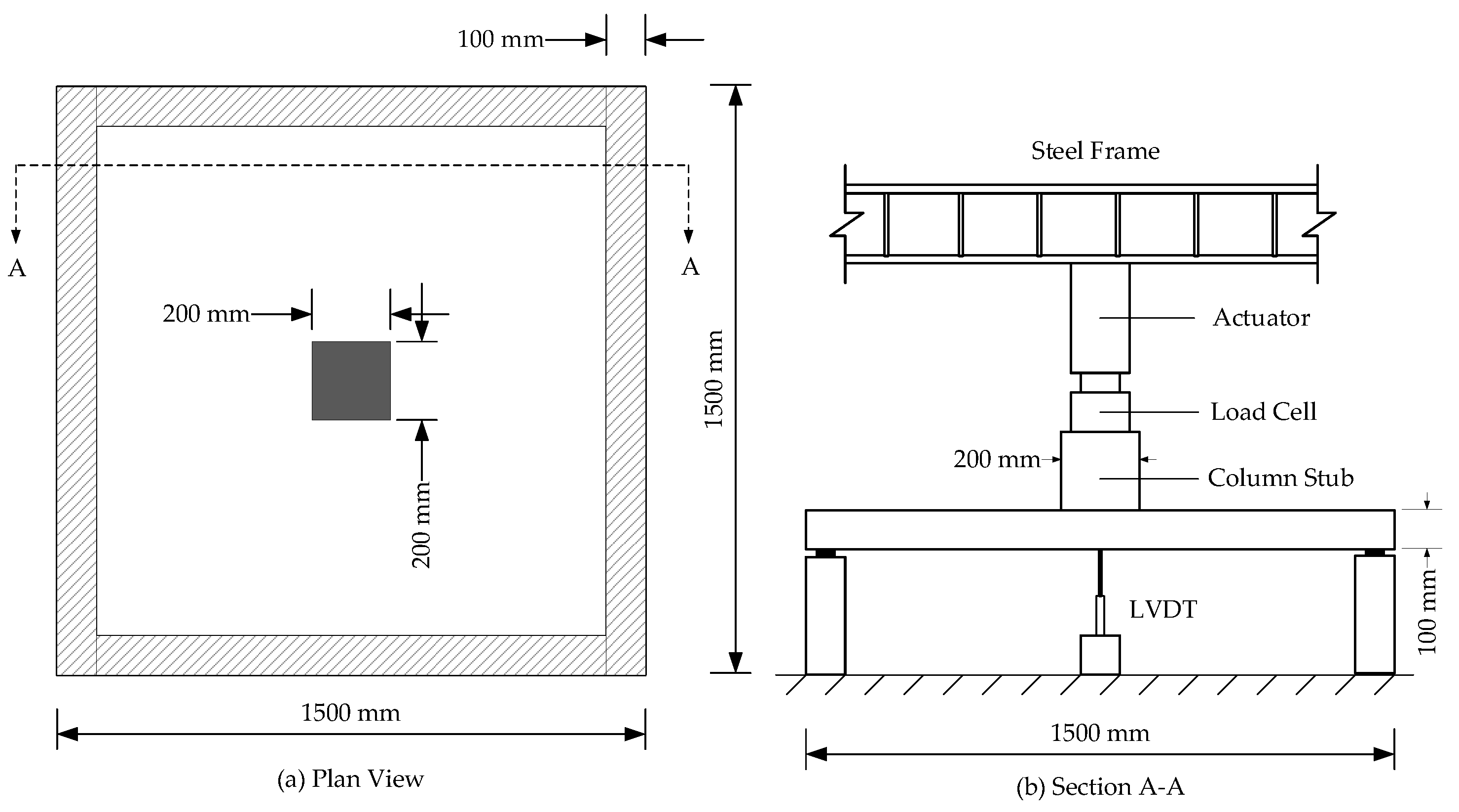
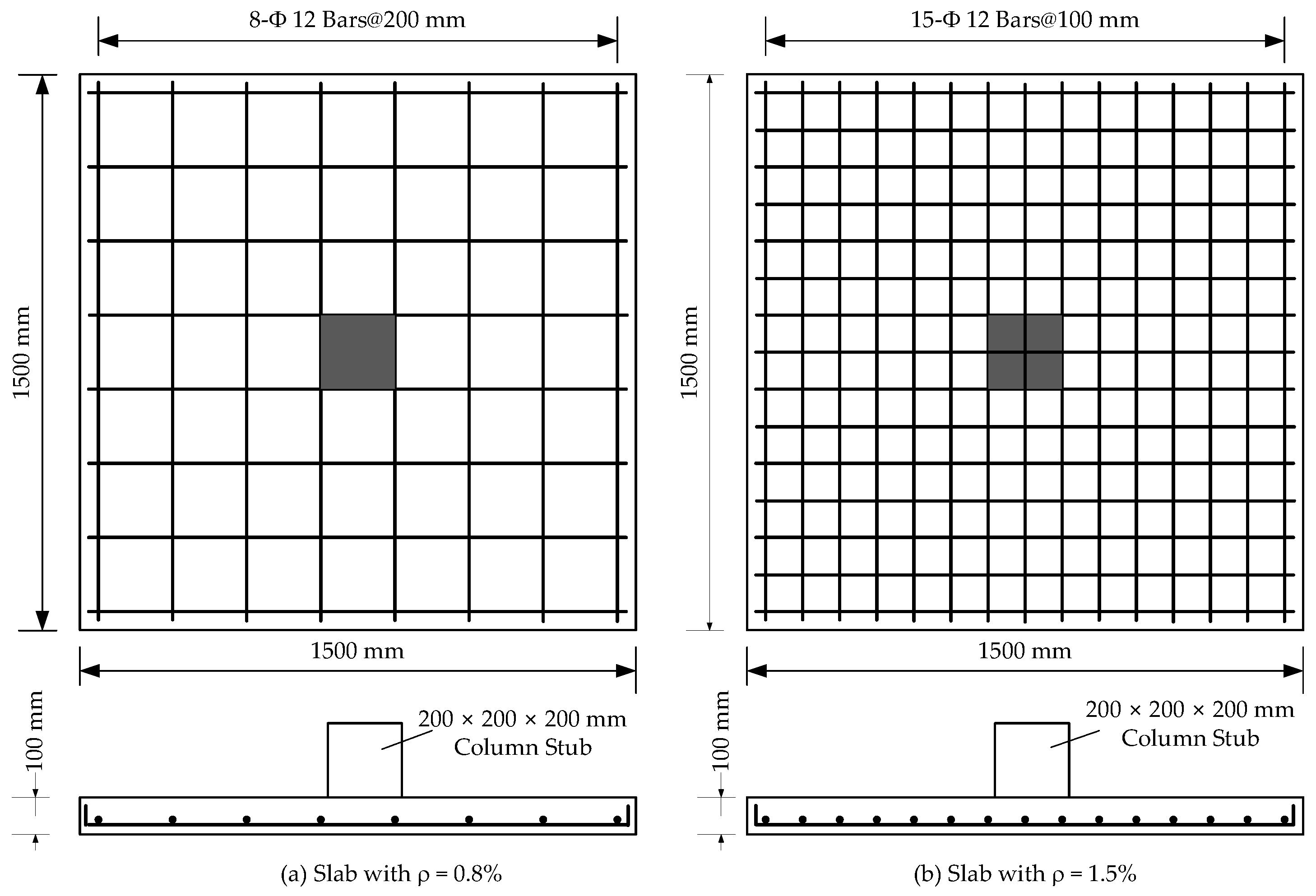
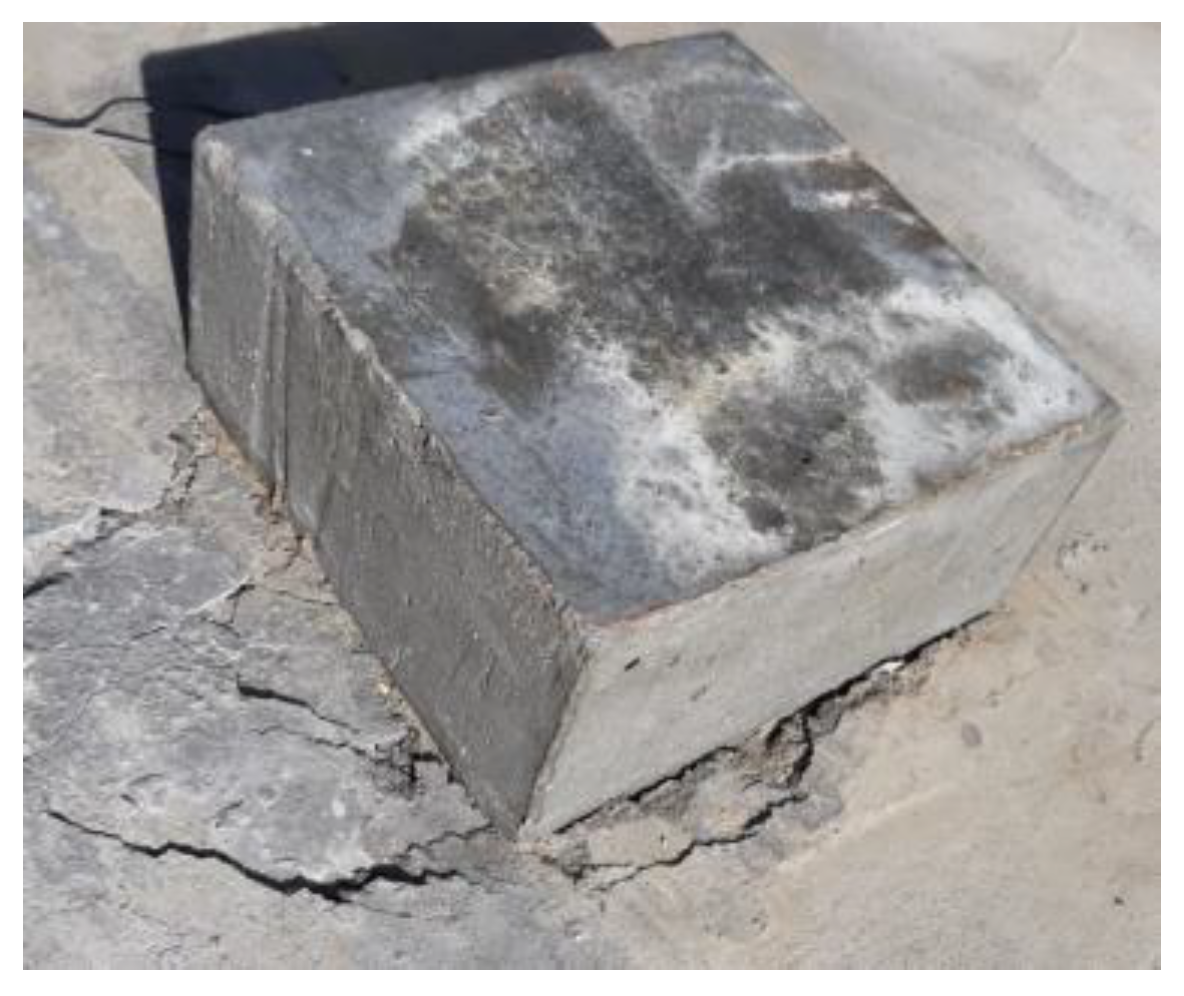
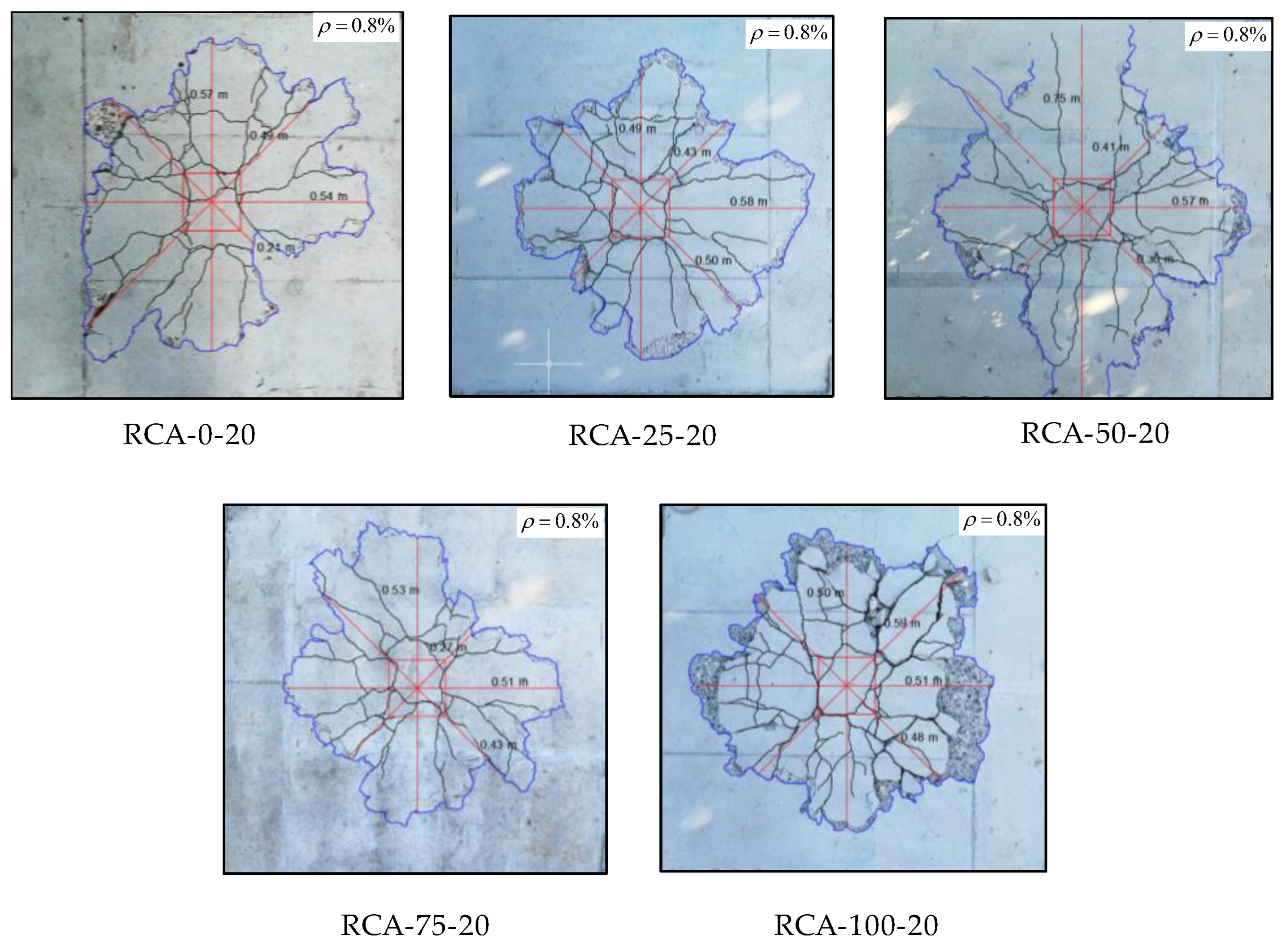
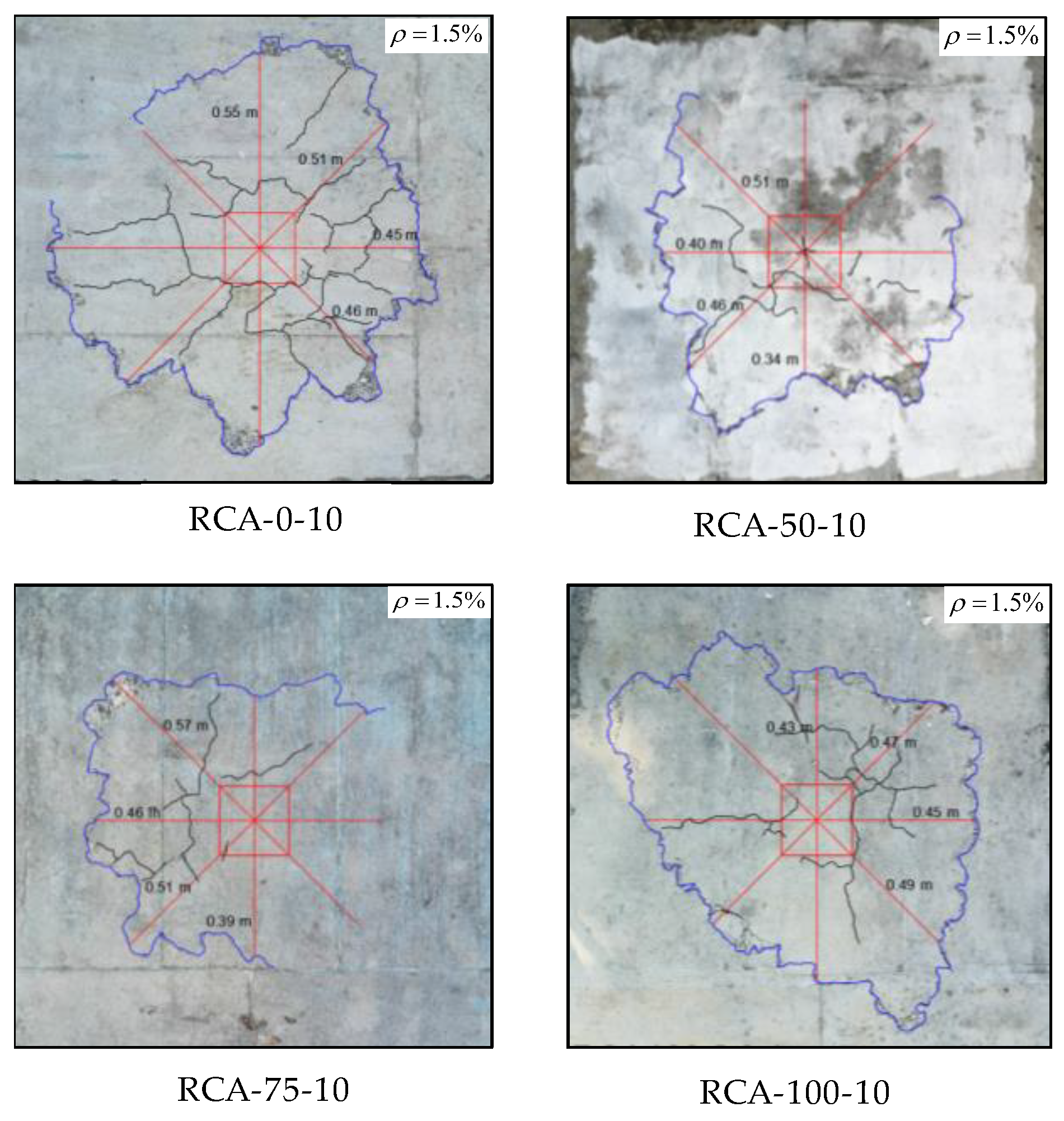

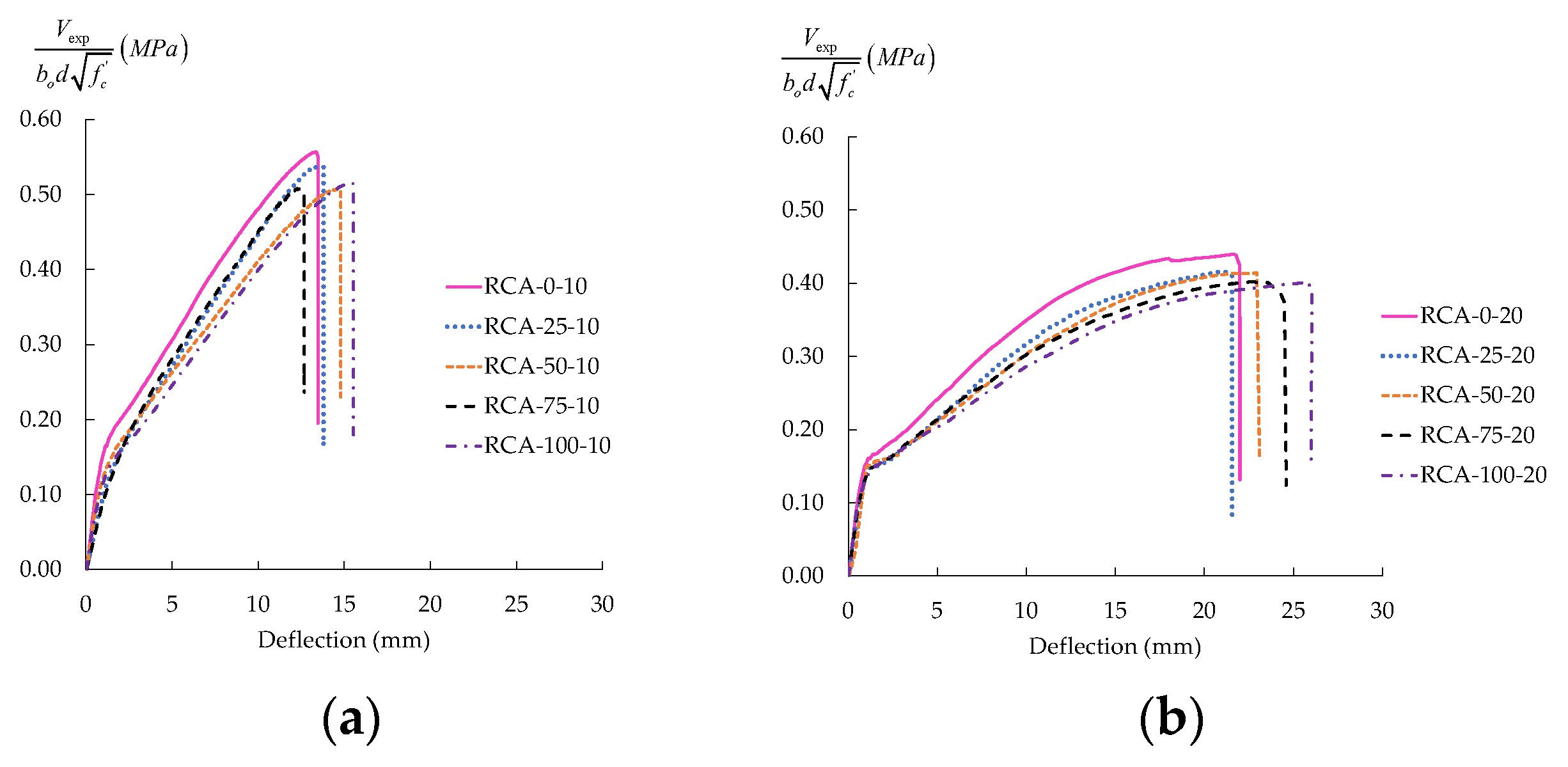
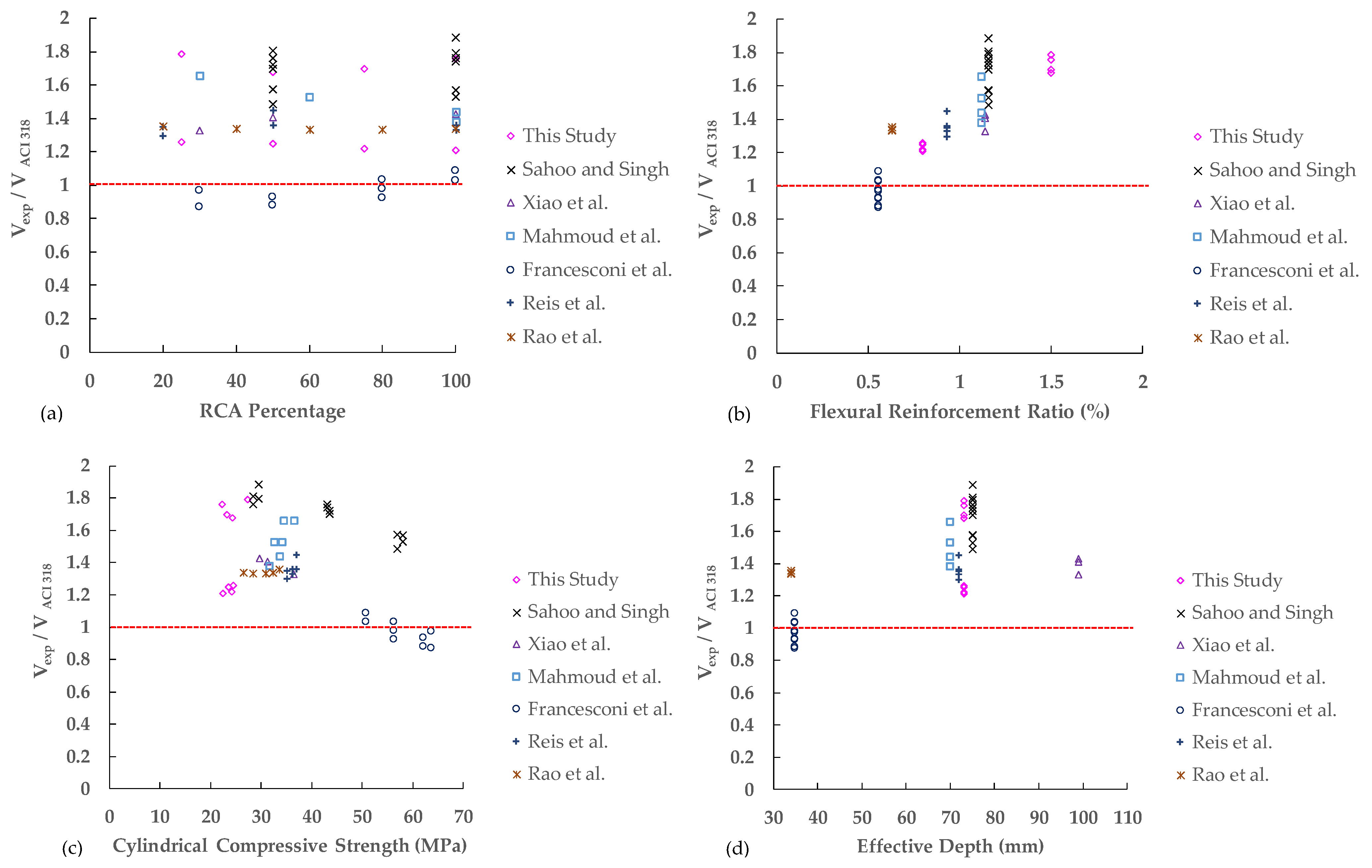


| Properties | FA | NCA | RCA |
|---|---|---|---|
| Bulk Specific Gravity (SSD) | 2.6 | 2.7 | 2.43 |
| Unit Weight (kg/m3) | - | 1730 | 1397 |
| Water Absorption (%) | 1.05 | 0.28 | 4.59 |
| Moisture (%) | 1.35 | 0.61 | 2.24 |
| Fineness Modulus | 2.7 | - | - |
| Max. size (mm) | 4.76 | 19.1 | 18.6 |
| Impact value (%) | - | 10.15 | 13.4 |
| Crushing value (%) | - | 21.77 | 23.12 |
| Mix Type | Cement | FA | NCA | RCA | Water | SP |
|---|---|---|---|---|---|---|
| NCA | 357 | 719 | 1069 | - | 190 | 1.07 |
| 25% RCA | 357 | 750 | 802 | 216 | 190 | 1.07 |
| 50% RCA | 357 | 780 | 535 | 432 | 190 | 1.07 |
| 75% RCA | 357 | 810 | 267 | 648 | 190 | 1.07 |
| 100% RCA | 357 | 840 | - | 864 | 190 | 1.07 |
| Specimen | RCA Replacement (%) | ρ (%) | f′c | Vcr | Vexp | Δu | Energy Absorption | |
|---|---|---|---|---|---|---|---|---|
| (MPa) | (kN) | (kN) | (mm) | (MPa) | (kN-mm) | |||
| RCA-0-10 | 0 | 1.5 | 28.1 | 76.8 | 260.9 | 13.5 | 0.62 | 2266 |
| RCA-25-10 | 25 | 1.5 | 27.2 | 70.0 | 245.3 | 13.8 | 0.59 | 2014 |
| RCA-50-10 | 50 | 1.5 | 24.3 | 62.0 | 217.8 | 14.8 | 0.55 | 2060 |
| RCA-75-10 | 75 | 1.5 | 23.1 | 61.0 | 214.8 | 12.7 | 0.56 | 1715 |
| RCA-100-10 | 100 | 1.5 | 22.2 | 59.0 | 217.5 | 15.5 | 0.58 | 2113 |
| RCA-0-20 | 0 | 0.8 | 26.5 | 65.1 | 180.0 | 22.0 | 0.44 | 2999 |
| RCA-25-20 | 25 | 0.8 | 24.5 | 58.5 | 164.0 | 21.6 | 0.42 | 2565 |
| RCA-50-20 | 50 | 0.8 | 23.5 | 57.6 | 159.8 | 23.1 | 0.41 | 2674 |
| RCA-75-20 | 75 | 0.8 | 24.1 | 58.1 | 156.9 | 24.5 | 0.40 | 2868 |
| RCA-100-20 | 100 | 0.8 | 22.3 | 54.2 | 150.4 | 26.0 | 0.40 | 2915 |
| Specimen | Vexp | VACI | Vexp/VACI | VEC2 | Vexp/VEC2 |
|---|---|---|---|---|---|
| (kN) | (kN) | (kN) | |||
| RCA-0-10 | 260.9 | 139.45 | 1.87 | 199.9 | 1.30 |
| RCA-25-10 | 245.3 | 137.20 | 1.79 | 197.8 | 1.24 |
| RCA-50-10 | 217.8 | 129.68 | 1.68 | 190.5 | 1.14 |
| RCA-75-10 | 214.8 | 126.43 | 1.70 | 187.3 | 1.15 |
| RCA-100-10 | 217.5 | 123.95 | 1.76 | 188.4 | 1.16 |
| RCA-0-20 | 180.0 | 135.42 | 1.33 | 159.0 | 1.13 |
| RCA-25-20 | 164.0 | 130.21 | 1.26 | 154.9 | 1.06 |
| RCA-50-20 | 159.8 | 127.52 | 1.25 | 152.8 | 1.05 |
| RCA-75-20 | 156.9 | 129.14 | 1.22 | 154.9 | 1.02 |
| RCA-100-20 | 150.4 | 124.23 | 1.21 | 149.5 | 1.01 |
| Authors | Specimen | RCA (%) | ρ (%) | d (mm) | fc′ (MPa) | Vexp (kN) | Vexp/VACI 318 | Vexp/VEC2 |
|---|---|---|---|---|---|---|---|---|
| This study | RCA-25-100 | 25 | 0.8 | 73 | 27.2 | 245.3 | 1.79 | 1.24 |
| RCA-50-100 | 50 | 0.8 | 73 | 24.3 | 217.8 | 1.68 | 1.14 | |
| RCA-75-100 | 75 | 0.8 | 73 | 23.1 | 214.8 | 1.70 | 1.15 | |
| RCA-100-100 | 100 | 0.8 | 73 | 22.2 | 217.5 | 1.76 | 1.16 | |
| RCA-25-200 | 25 | 1.5 | 73 | 24.5 | 164.0 | 1.26 | 1.06 | |
| RCA-50-200 | 50 | 1.5 | 73 | 23.5 | 159.8 | 1.25 | 1.05 | |
| RCA-75-200 | 75 | 1.5 | 73 | 24.1 | 156.9 | 1.22 | 1.02 | |
| RCA-100-200 | 100 | 1.5 | 73 | 22.3 | 150.4 | 1.21 | 1.01 | |
| Sahoo et al. [45] | N50-1 | 50 | 1.16 | 75 | 28.4 | 211.5 | 1.76 | 1.58 |
| N50-2 | 50 | 1.16 | 75 | 28.4 | 217.0 | 1.81 | 1.63 | |
| N100-1 | 100 | 1.16 | 75 | 29.4 | 218.9 | 1.80 | 1.62 | |
| N100-2 | 100 | 1.16 | 75 | 29.4 | 230.0 | 1.89 | 1.70 | |
| M50-1 | 50 | 1.16 | 75 | 43.5 | 252.6 | 1.70 | 1.64 | |
| M50-2 | 50 | 1.16 | 75 | 43.5 | 255.8 | 1.72 | 1.66 | |
| M100-1 | 100 | 1.16 | 75 | 43 | 257.1 | 1.74 | 1.68 | |
| M100-2 | 100 | 1.16 | 75 | 43 | 260.1 | 1.76 | 1.70 | |
| H50-1 | 50 | 1.16 | 75 | 56.8 | 252.4 | 1.49 | 1.50 | |
| H50-2 | 50 | 1.16 | 75 | 56.8 | 267.5 | 1.57 | 1.59 | |
| H100-1 | 100 | 1.16 | 75 | 58.0 | 263.4 | 1.53 | 1.55 | |
| H100-2 | 100 | 1.16 | 75 | 58.0 | 270.4 | 1.57 | 1.59 | |
| Xiao et al. [44] | RAC30-0% | 30 | 1.14 | 99 | 36.34 | 313.4 | 1.33 | 1.23 |
| RAC50-0% | 50 | 1.14 | 99 | 31.16 | 307.1 | 1.41 | 1.27 | |
| RAC100-0% | 100 | 1.14 | 99 | 29.64 | 303.4 | 1.43 | 1.28 | |
| Mahmoud et al. [43] | RCA-30%-12.5 | 30 | 1.12 | 70 | 34.5 | 153.0 | 1.66 | 1.22 |
| RCA-60%-12.5 | 60 | 1.12 | 70 | 32.5 | 137.5 | 1.53 | 1.11 | |
| RCA-100%-12.5 | 100 | 1.12 | 70 | 31.6 | 122.0 | 1.38 | 1.00 | |
| RCA-30%-25 | 30 | 1.12 | 70 | 36.4 | 157.0 | 1.66 | 1.23 | |
| RCA-60%-25 | 60 | 1.12 | 70 | 34.1 | 140.5 | 1.53 | 1.12 | |
| RCA-100%-25 | 100 | 1.12 | 70 | 33.6 | 131.0 | 1.44 | 1.05 | |
| Francesconi et al. [42] | RC1-1 | 30 | 0.56 | 35 | 63.6 | 64.9 | 0.87 | 1.27 |
| RC1-2 | 30 | 0.56 | 35 | 63.6 | 72.5 | 0.97 | 1.42 | |
| RC1-3 | 30 | 0.56 | 35 | 63.6 | 72.5 | 0.97 | 1.42 | |
| RC2-1 | 50 | 0.56 | 35 | 62.0 | 64.9 | 0.88 | 1.28 | |
| RC2-2 | 50 | 0.56 | 35 | 62.0 | 68.7 | 0.93 | 1.36 | |
| RC2-3 | 50 | 0.56 | 35 | 62.0 | 64.9 | 0.88 | 1.28 | |
| RC3-1 | 80 | 0.56 | 35 | 56.3 | 68.7 | 0.98 | 1.40 | |
| RC3-2 | 80 | 0.56 | 35 | 56.3 | 64.9 | 0.92 | 1.33 | |
| RC3-3 | 80 | 0.56 | 35 | 56.3 | 72.5 | 1.03 | 1.48 | |
| RC4-1 | 100 | 0.56 | 35 | 50.8 | 68.7 | 1.03 | 1.45 | |
| RC4-2 | 100 | 0.56 | 35 | 50.8 | 68.7 | 1.03 | 1.45 | |
| RC4-3 | 100 | 0.56 | 35 | 50.8 | 72.5 | 1.09 | 1.53 | |
| Reis et al. [41] | C20-1 | 20 | 0.93 | 72 | 35.1 | 158.6 | 1.35 | 1.27 |
| C20-2 | 20 | 0.93 | 72 | 35.1 | 152.2 | 1.30 | 1.22 | |
| C50-1 | 50 | 0.93 | 72 | 36.9 | 163.6 | 1.36 | 1.29 | |
| C50-2 | 50 | 0.93 | 72 | 36.9 | 174.8 | 1.45 | 1.38 | |
| C100-1 | 100 | 0.93 | 72 | 36.2 | 161.8 | 1.36 | 1.28 | |
| C100-2 | 100 | 0.93 | 72 | 36.2 | 158.3 | 1.33 | 1.26 | |
| Rao et al. [40] | RCAC-20-S | 20 | 0.63 | 34 | 33.5 | 47.2 | 1.36 | 1.34 |
| RCAC-40-S | 40 | 0.63 | 34 | 32.4 | 45.8 | 1.34 | 1.31 | |
| RCAC-60-S | 60 | 0.63 | 34 | 30.9 | 44.6 | 1.33 | 1.30 | |
| RCAC-80-S | 80 | 0.63 | 34 | 28.4 | 42.8 | 1.34 | 1.28 | |
| RCAC-100-S | 100 | 0.63 | 34 | 26.4 | 41.4 | 1.34 | 1.27 | |
| Mean | 1.39 | 1.34 | ||||||
| Standard Deviation | 0.29 | 0.20 |
| Specimen | Vexp | Vyield-line | Vexp/Vyield-line |
|---|---|---|---|
| (kN) | (kN) | ||
| RCA-0-10 | 260.9 | 300.7 | 0.87 |
| RCA-25-10 | 245.3 | 298.5 | 0.82 |
| RCA-50-10 | 217.8 | 290.1 | 0.75 |
| RCA-75-10 | 214.8 | 286.0 | 0.75 |
| RCA-100-10 | 217.5 | 287.4 | 0.76 |
| RCA-0-20 | 180 | 166.3 | 1.08 |
| RCA-25-20 | 164 | 164.9 | 0.99 |
| RCA-50-20 | 159.8 | 164.0 | 0.97 |
| RCA-75-20 | 156.9 | 164.5 | 0.95 |
| RCA-100-20 | 150.4 | 162.6 | 0.92 |
Publisher’s Note: MDPI stays neutral with regard to jurisdictional claims in published maps and institutional affiliations. |
© 2022 by the authors. Licensee MDPI, Basel, Switzerland. This article is an open access article distributed under the terms and conditions of the Creative Commons Attribution (CC BY) license (https://creativecommons.org/licenses/by/4.0/).
Share and Cite
Leelatanon, S.; Imjai, T.; Setkit, M.; Garcia, R.; Kim, B. Punching Shear Capacity of Recycled Aggregate Concrete Slabs. Buildings 2022, 12, 1584. https://doi.org/10.3390/buildings12101584
Leelatanon S, Imjai T, Setkit M, Garcia R, Kim B. Punching Shear Capacity of Recycled Aggregate Concrete Slabs. Buildings. 2022; 12(10):1584. https://doi.org/10.3390/buildings12101584
Chicago/Turabian StyleLeelatanon, Satjapan, Thanongsak Imjai, Monthian Setkit, Reyes Garcia, and Boksun Kim. 2022. "Punching Shear Capacity of Recycled Aggregate Concrete Slabs" Buildings 12, no. 10: 1584. https://doi.org/10.3390/buildings12101584
APA StyleLeelatanon, S., Imjai, T., Setkit, M., Garcia, R., & Kim, B. (2022). Punching Shear Capacity of Recycled Aggregate Concrete Slabs. Buildings, 12(10), 1584. https://doi.org/10.3390/buildings12101584







